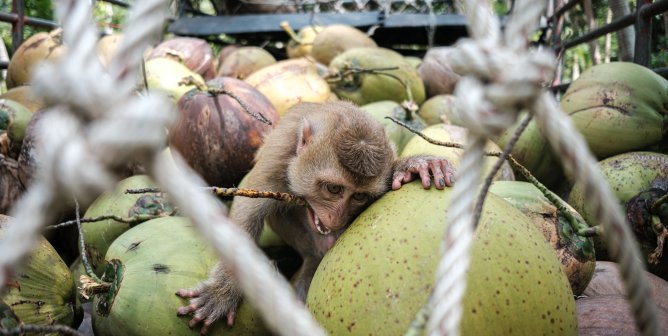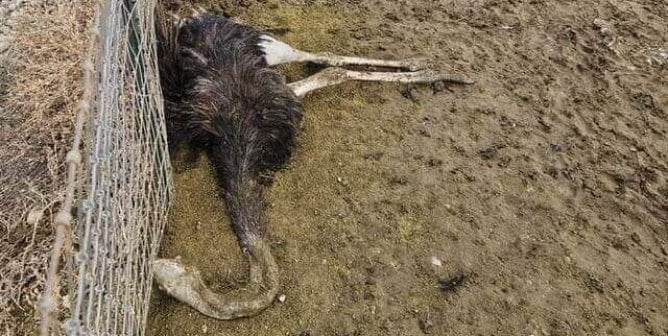Fishing: Aquatic Agony
Like the animals many people share their homes with, fish are individuals who have their own unique personalities. Dive guides have been known to name friendly fish who follow divers around and enjoy being petted, just as dogs and cats do. Yet billions of fish die every year in nets and on hooks—some are destined for human consumption, many are tortured just for “sport,” and others are non-target victims who are maimed or killed simply because they were in the wrong place at the wrong time.
Fish Can Communicate, Make Tools, Think, and Feel Pain
According to Culum Brown, a researcher at Macquarie University in Sydney, “Fish are more intelligent than they appear. In many areas, such as memory, their cognitive powers match or exceed those of ‘higher’ vertebrates including non-human primates.”1 In Fish and Fisheries, biologists wrote that fish are “steeped in social intelligence, pursuing Machiavellian strategies of manipulation, punishment and reconciliation, exhibiting stable cultural traditions, and cooperating to inspect predators and catch food.”2 Many species of fish learn how to avoid predators by watching experienced fish, and according to Dr. Jens Krause of the University of Leeds, while some fish live in large hierarchical societies and others have smaller family units, all rely on these “social aggregations,” which “act as an information center where fish can exchange information with each other.”3 Even sharks have demonstrated intelligence, curiosity, playfulness, the ability to learn through trial and error, and the ability to maintain social networks.4
Fish communicate through a range of low-frequency sounds—from buzzes and clicks to yelps and sobs. These sounds, most of which are only audible to humans with the use of special instruments, communicate emotional states such as alarm or delight and help with courtship.5 Atlantic croakers, for example, are so named because they croak when they are frightened.6 Scientists have discovered that the alto croaking sounds made by a rare fish believed to be similar to the deep-sea blue grenadier, a tiny fish who lives beyond the continental shelves and is in danger of being fished to extinction.7
While fish do not always express pain and suffering in ways that humans can easily recognize, scientific reports from around the world substantiate the fact that fish feel pain.8 Victoria Braithwaite, Penn State professor of fisheries and biology, has spent decades studying fish and asserts that, “(i)n our experiments we showed that if we hurt fish, they react, and then if we give them pain relief, they change their behavior, strongly indicating that they feel pain.”9 The American Veterinary Medical Association’s guidelines for the euthanasia of animals say that, “Suggestions that finfish responses to pain merely represent simple reflexes have been refuted. … the preponderance of accumulated evidence supports the position that finfish should be accorded the same considerations as terrestrial vertebrates in regard to relief from pain.”10 Anglers often claim that fish do not feel pain, yet they go to great lengths to hide their hooks with bait and lures, knowing that even fish who have already experienced being hooked and released will continue to seek out food and that those who do get hooked will fight to stay alive.
Hooked fish struggle because of fear and physical pain. Once fish are taken out of their natural environment and pulled into ours, they begin to suffocate. Their gills often collapse, and their swim bladders can rupture because of the sudden change in pressure. Some deepwater species, such as red snapper, are particularly affected by the dramatic changes in pressure that occur when they are pulled to the surface. One scientist says, “The physiological stress is enormous. Even if they swim off, a lot of those fish will be easy prey because they’re in a stunned condition when they’re released.”11
‘Sport’ Fishing
While the numbers continue to decline compared to decades ago, more than 39 million people went fishing in 2022, spending billions of dollars on their “hobby.”12
Many trout streams are so intensively fished that they are subject to catch-and-release regulations, requiring that all fish caught be released; the aquatic animals in these streams are likely to spend their short lives being repeatedly traumatized and injured. A study of marine shiner perch found that the fish who suffered injuries from hooks “experienced a 35 percent reduction in feeding ability.”13 One fishery expert adds that catch-and-release victims “could be vulnerable to predators, unable to swim away, or if nesting, not capable of fending off nest raiders. Some guarding males could in fact abandon the nest.”14
Fish aren’t the only victims of sport fishing. National Geographic reports that most of the Great Pacific Garbage Patch–the world’s largest collection of floating trash– is made up of “abandoned fishing gear,” with 46 percent of the garbage pile comprised of fishing nets.15,16 The Florida Fish and Wildlife Conservation Commission reports that discarded monofilament fishing line is the number one killer of adult brown pelicans.17 In Florida alone, thousands of other wading and diving birds become entangled in abandoned fishing line, sometimes struggling for days before they die from drowning, starvation, dehydration or strangulation.18 Osprey and other birds sometimes use discarded fishing line in their nests, and both parents and their young have been found entangled in it or impaled on fishing hooks.19 Dolphins have also died from asphyxiation after choking on fish who had tackle still attached.20
Commercial Fishing
The average U.S. consumer eats nearly 19 pounds of fish and shellfish every year. To meet this demand, U.S. commercial fishers reel in more than 8 billion pounds of fish and shellfish annually, the aquaculture industry raises more than 650 million pounds per year, and another 6 billion pounds of seafood is imported.21
Commercial fishers use vast factory-style trawlers the size of football fields to catch fish. Miles-long nets stretch across the ocean, capturing everyone in their path. These boats haul up tens of thousands of fish in one load, keeping the most profitable and dumping other animals (such as rays, dolphins, and crabs) back into the ocean. Fish are scraped raw from rubbing against the rocks and debris that are caught in the nets with them. Then they bleed or suffocate to death on the decks of the ships, gasping for oxygen and suffering for as long as 24 hours.22 Millions of tons of fish who are considered to be “undersized” are left to die on the decks or are tossed back into the ocean, where they usually die soon afterward.23
Some fishing boats use gill nets, which ensnare every animal they catch, and fish are mutilated when they are extracted from the nets. These kinds of nets are believed to be responsible for the majority of incidents involving the accidental netting and death of hundreds of thousands of marine mammals over decades of use.24 The National Oceanic and Atmospheric Administration reported 67 cases of whale entanglement off United States coasts in 2022.25
Longline fishing—in which 40 miles of monofilament fishing line dangles thousands of individually baited hooks to catch tuna and swordfish—kills thousands of turtles and birds every year.26 Because of the fishing industry’s indiscriminate practices, the population of the world’s large predatory fish, such as swordfish and marlin, has declined by 90 percent since the advent of industrialized fishing.27 The population of Pacific bluefin tuna has decreased by 96 percent in the same timeframe.28 According to the United Nations Food and Agriculture Organization, 35 percent of the world’s fish populations for which data are available are “fished at biologically unsustainable levels.”29
Fishing is threatening shark populations, too, with more than 100 million killed every year.30 One underwater photographer says that when he works off the north coast of New South Wales, he finds that “almost every second grey nurse shark … has a hook hanging out of its mouth, with a bit of trailing line following it.”31 Many sharks are the victims of “finning,” in which fishers catch sharks, haul them on deck, hack off their fins (for expensive shark fin soup), and toss the maimed, helpless animals back into the ocean to die in agony.32
Eating Fish Is Hazardous to Your Health
Like the flesh of other animals, the flesh of sea animals contains excessive amounts of protein, fat, and cholesterol, and more than 6 million Americans are believed to be allergic to shellfish.33
The flesh of fish (including shellfish) can accumulate extremely high levels of carcinogenic chemical residues, such as polychlorinated biphenyls (PCBs), thousands of times higher than that of the water they live in.34 A study of the nation’s freshwater waterways concluded that one in four fish is contaminated with levels of mercury that exceed government standards for safety.35 The New England Journal of Medicine asserts that fish “are the main if not the only source of methyl mercury,” which has been linked to cardiovascular disease, fetal brain damage, blindness, deafness, and problems with motor skills, language, and attention span.36,37 Because of mercury levels in the flesh of marine animals, the Environmental Protection Agency and the FDA warn women of child-bearing age and children to refrain from eating fish such as shark, swordfish, and king mackerel and to consume less than 12 ounces a week of other fish flesh.38
What You Can Do
Never buy or eat fish. Grains, legumes, vegetables, nuts, and seeds provide all the essential amino acids that you need. Vegetarian products like mock lobster, shrimp, and crab have all the taste of the “real thing” but none of the cruelty or contaminants. Omega-3 fatty acids, which help prevent heart disease, can be found in flaxseeds, canola oil, nuts, and avocados.39 Recipes for fabulous, healthy, and animal-friendly vegetarian dishes, including faux fish sticks and sushi, can be found at PETA.org.
To combat fishing in your area, post “no fishing” signs on your land if you have a pond or a lake, join or form an anti-fishing organization, and protest fishing tournaments. Encourage your legislators to enact or enforce wildlife-protection laws. Before you support a “wildlife” or “conservation” group, ask about its position on fishing. Groups such as the National Wildlife Federation, the National Audubon Society, the Sierra Club, the Izaak Walton League, the Wilderness Society, the World Wildlife Fund, and many others either support or do not oppose sport fishing.
References
1Harry Pearson, “Do Fish Have Feelings Too?” The Guardian 21 June 2007.
2BBC News, “Scientists Highlight Fish ‘Intelligence,’” 31 Aug. 2003.
3NPR, “Study: Fish Smarter than Thought,” All Things Considered 5 Sept. 2003.
4R. Aiden Martin, “Biology of Sharks and Rays,” ReefQuest Center for Shark Research, last accessed 13 Oct. 2018.
5Kerry Grens, “Fish Use a Variety of Sounds to Communicate,” The Scientist, 1 Mar. 2017.
6Martin A. Connaughton et al., “Characterization of Sounds and Their Use in Two Sciaenid Species: Weakfish and Atlantic Croaker,” An International Workshop on the Application of Passive Acoustics in Fisheries, 8–10 Apr. 2002.
7Mark Peplow, “Deep-Sea Fish Croaks for Love,” Nature News Service, 28 Apr. 2004.
8Tim Carman, “Scientists Say Fish Feel Pain. It Could Lead To Major Changes in The Fishing Industry,” The Washington Post, 24 May 2018.
9Michael Bezilla, “Researcher Explores Whether Fish Feel Pain,” Penn State News, 16 Nov. 2010.
10American Veterinary Medical Association, “AVMA Guidelines for the Euthanasia of Animals: 2013 Edition,” 2013.
11Associated Press, “Sport Anglers Said to Catch More Fish Than Thought,” 27 Aug. 2004.
12U.S. Fish and Wildlife Service, “2022 National Survey of Fishing, Hunting, and Wildlife-Associated Recreation,” United States Census Bureau, Sept. 2023.
13Abbey Interrante, “Catch And Release Fishing Makes It Harder for Fish To Eat,” Newsweek, 11 Oct. 2018.
14Dave Golowenski, “Study Shows Effects of Catch-and-Release. Research Raises Questions About Harm to Fish During Long Struggle,” The Columbus Dispatch 4 July 2004.
15Laura Parker, “The Great Pacific Garbage Patch Isn’t What You Think it Is,” National Geographic 22 Mar. 2018.
16L. Lebreton et al.,”Evidence that the Great Pacific Garbage Patch Is Rapidly Accumulating Plastic,” Scientific Reports, 4666(2018).
17Jeff Klinkenberg, “Light But Lethal, Stray Fishing Line Takes Toll on Seabirds,”Tampa Bay Times 23 Oct. 2014.
18Kevin Lollar, “Discarded Fishing Line Is A Potential Deathtrap,” News-Press 16 May 2014.
19Wildlife Center of Virginia, “Fishing Tackle: Threats to Wildlife,” last accessed 20 Oct. 2024.
20Megan Stolen, “Fatal Asphyxiation in Bottlenose Dolphins (Tursiops truncates) From the Indian River Lagoon,” PLoS ONE 8 (2013).
21National Marine Fisheries Service, Office of Science and Technology, “2020 Fisheries of the United States,” U.S. Department of Commerce, May 2022.
22Dawn Carr, personal experience on fishing trawler, Summer 2003.
23Dirk Zeller et al., “Global Marine Fisheries Discards: A Synthesis of Reconstructed Data,” Fish and Fisheries 19(2018):30–39.
24Andrew J. Read, “Marine Mammal ByCatch in U.S. and Global Fisheries,” Marine Mammal Commission Annual Meeting Washington, D.C., 7 May 2014.
25NOAA Fisheries, “National Report on Large Whale Entanglements Confirmed in the United States in 2022,” National Oceanic and Atmospheric Association, Jan. 2024.
26Janet Raloff, “Hooking Fish, Not Endangered Turtles,” ScienceNews 11 Nov. 2011.
27Ransom A. Myers and Boris Worm, “Rapid Worldwide Depletion of Predatory Fish Communities,” Nature 15 May 2003.
28Brad Plumer, “Overfishing Has Wiped out 96 Percent of Pacific Bluefin Tuna,” Vox.com, 23 Apr. 2014.
29Food and Agriculture Organization of the United Nations, “The State of World Fisheries and Aquaculture 2022,” accessed 23 June 2024.
30Press Association, “Sharks at Risk of Overfishing, Say Scientists,” The Guardian 2 Mar. 2013.
31Scott Bevan, “Restricted Areas to Protect Endangered Shark,” ABC News, 13 Nov. 2007.
32Press Association.
33Andreas L. Lopata et al.,”Allergens and Molecular Diagnostics of Shellfish Allergy,” Allergo Journal International, 7(2016): 210–218.
34U.S. Department of Health and Human Services, “ToxFAQs for Polychlorinated Biphenlys (PCBs),” Agency for Toxic Substances and Disease Registry, Jul. 2014.
35B.C. Scudder et al., “Mercury in Fish, Bed Sediment, and Water From Streams Across the United States, 1998–2005,” U.S. Geological Survey Scientific Investigations Report 2009–5109, 2009.
36Thomas Clarkson et al., “The Toxicology of Mercury—Current Exposures and Clinical Manifestations,” The New England Journal of Medicine 349 (2003): 1731–7.
37Stephan Boese-O´Reilly MD MPH, et al., “Mercury Exposure and Children’s Health,” Current Problems in Pediatric and Adolescent Health Care 40(2010):186-215.
38Food and Drug Administration, “Advice About Eating Fish,” U.S. Department of Health and Human Services and U.S. Environmental Protection Agency, Oct. 2021.
39Sally Squires, “Heart-Healthy Omega-3 May Be Good for Your Brain,” The Washington Post , 19 Aug. 2003.








